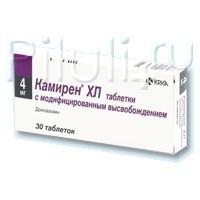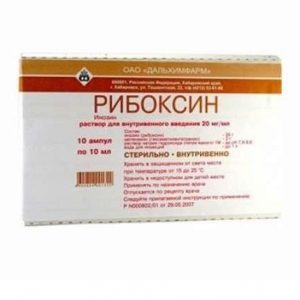Description
Release form
modified release tablets.
Packing
30 pcs.
Pharmacological action
Doxazosin is a selective competitive blocker of postsynaptic alpha1-adrenergic receptors. Due to a decrease in vascular muscle tone, doxazosin reduces total peripheral vascular resistance, which leads to a decrease in blood pressure (BP). After a single dose of the drug, the maximum antihypertensive effect is observed in the period from 2 to 6 hours, and in general, the antihypertensive effect persists for 24 hours. During treatment with doxazosin in patients with arterial hypertension, there are no differences in blood pressure values in the standing and lying positions.
Effective in arterial hypertension, including those accompanied by metabolic disorders (obesity, decreased glucose tolerance).
Reduces the risk of coronary heart disease.
Taking the drug in people with normal blood pressure (BP) is not accompanied by a decrease in blood pressure. With prolonged use of doxazosin in patients, there is no change in tolerance to the therapeutic antihypertensive effect.
During treatment with doxazosin, a decrease in the concentration level of plasma triglycerides, total cholesterol, is observed. At the same time, there has been some (4 13%) increase in HDL / total cholesterol.
With prolonged treatment with doxazosin, regression of left ventricular hypertrophy, suppression of platelet aggregation, and increased tissue plasminogen content are observed.
Due to the fact that doxazosin blocks alpha1-adrenergic receptors located in the stroma and capsule of the prostate gland and in the neck of the bladder, there is a decrease in resistance and pressure in the urethra, a decrease in the resistance of the internal sphincter. Therefore, the administration of doxazosin to patients with symptoms of benign prostatic hyperplasia leads to a significant improvement in urodynamics and a decrease in the manifestation of symptoms of the disease. It has an effect in 66-71% of patients, the onset of action – after 1-2 weeks of treatment, maximum – after 14 weeks, the effect persists for a long time. Compared to the tablet formulation and the modified release tablet formulation, the latter improves the relationship between efficacy and safety. Doxazosin is a selective competitive blocker of postsynaptic alpha1-adrenergic receptors. Due to a decrease in vascular muscle tone, doxazosin reduces total peripheral vascular resistance, which leads to a decrease in blood pressure (BP). After a single dose of the drug, the maximum antihypertensive effect is observed in the period from 2 to 6 hours, and in general, the antihypertensive effect persists for 24 hours. During treatment with doxazosin in patients with arterial hypertension, there are no differences in blood pressure values in the standing and lying positions.
Effective in hypertension, including accompanied by metabolic disorders (obesity, decreased glucose tolerance).
Reduces the risk of coronary heart disease.
Taking the drug in people with normal blood pressure (BP) is not accompanied by a decrease in blood pressure. With prolonged use of doxazosin in patients, there is no change in tolerance to the therapeutic antihypertensive effect.
During treatment with doxazosin, a decrease in the concentration level of plasma triglycerides, total cholesterol, is observed. At the same time, there has been some (4 13%) increase in HDL / total cholesterol.
With prolonged treatment with doxazosin, regression of left ventricular hypertrophy, suppression of platelet aggregation, and increased tissue plasminogen content are observed.
Due to the fact that doxazosin blocks alpha1-adrenergic receptors, located in the stroma and capsule of the prostate gland and in the neck of the bladder, there is a decrease in resistance and pressure in the urethra, a decrease in the resistance of the internal sphincter. Therefore, the administration of doxazosin to patients with symptoms of benign prostatic hyperplasia leads to a significant improvement in urodynamics and a decrease in the manifestation of symptoms of the disease. It has an effect in 66-71% of patients, the onset of action – after 1-2 weeks of treatment, maximum – after 14 weeks, the effect persists for a long time. Compared to the tablet formulation and the modified release tablet formulation, the latter improves the relationship between efficacy and safety.
Indications
The drug is recommended for the treatment of mild or moderate arterial hypertension (in combination with other antihypertensive agents – thiazide diuretics, beta-blockers, slow calcium channel blockers, angiotensin-converting enzyme inhibitors (APF)) prostate hyperplasia
Contraindications
Camiren CL should not be prescribed to patients with hypersensitivity to doxazosin and other quinazoline derivatives (prazosin, terazosin) or to other components of the drug, under the age of 18 years (efficacy and safety have not been established).
Use with caution in case of aortic or mitral stenosis, in patients with impaired liver and / or kidney function, orthostatic hypotension.
Use during pregnancy and lactation
Pregnant women can be prescribed the drug only for health reasons, when the benefits to the mother outweigh the potential risk to the fetus / baby. The safety of the drug in infants has not been established, therefore, nursing mothers are advised to stop feeding during the treatment with doxazosin.
Special instructions
Special caution should be exercised when prescribing this drug to patients with impaired liver function, especially in those cases when drugs that can adversely affect liver function are used at the same time. In cases of deterioration of the functional state of the liver, the drug is immediately canceled.
In order to prevent orthostatic reactions, patients should avoid sudden and abrupt changes in body position (moving from a lying position to a standing position).
Alcohol intake can increase adverse reactions.
Safety and efficacy of doxazosin in children have not been established, therefore, it is not recommended to prescribe the drug to children.
The effect of the “first” administration of the drug is especially pronounced against the background of previous diuretic therapy and a sodium-restricted diet.
Before starting therapy, it is necessary to exclude cancerous degeneration of the prostate gland.
Due to the fact that doxazosin is able to cause orthostatic reactions at the beginning of treatment or during a period of increasing dosages, it is advisable for patients to refrain from all potentially dangerous activities, in particular from driving vehicles and other vehicles and mechanisms.
Composition
1 tablet with a modified release contains the active substance doxazosin mesylate 4.85 mg (corresponds to 4 mg doxazosin).
Excipients: hypromellose, calcium hydrogen phosphate anhydrous, lactose monohydrate, magnesium stearate shell: dye Opadry white – hypromellose, titanium dioxide (E 171), Macrogol 400.
Dosage and administration
Inside, once a day (morning or evening), regardless of food intake, without chewing and drinking plenty of water.
The dose of the drug should be adjusted depending on the effectiveness of the drug or possible side effects in specific patients. Patients with hepatic insufficiency require lower doses due to the slowed metabolism of the drug.
If the patient has forgotten to take the drug at the usual time, he should take the appropriate dose of the drug as soon as possible. If the time is right for the next dose, then only it should be taken (without doubling the dose of the drug). It is important to take the drug regularly. If the patient has not taken the drug for several days, then the new therapeutic course should be started with the lowest dose.
Arterial hypertension: The usual dose of Camirene CL is 1 tablet (4 mg) per day. Its effect can be observed already on the first day, the therapeutic effect occurs 4 weeks after the start of treatment. After 4 weeks in case of good tolerance of the drug and if the doctor considers the effect insufficient, higher doses may be prescribed. The maximum recommended daily dose of Camiren CL is 2 tablets (8 mg) in one dose.
If the therapeutic effect is not enough, patients can simultaneously receive other antihypertensive drugs: beta-blockers, diuretics, slow calcium channel blockers and ACE inhibitors.
After achieving a stable therapeutic effect, the dose is usually somewhat reduced (the average therapeutic dose with maintenance therapy is usually 2-4 mg per day), you can go on taking CAMIREN, tablets of 2 or 4 mg.
Benign prostatic hyperplasia in patients with normal blood pressure: the usual dose is 1 tablet (4 mg) CAMIRENA CL per day. The patient should take the first dose in the evening before bedtime. Depending on the effect of the drug, the dose can be gradually increased at intervals of 1-2 weeks to 8 mg once a day. As a rule, the average daily dose is from 2 mg to 4 mg, you can go on taking CAMIRENA, tablets of 2 or 4 mg. The maximum daily dose is 8 mg.
Benign prostatic hyperplasia in patients with arterial hypertension: the doses of the drug are the same as in the case of arterial hypertension without benign prostatic hyperplasia (see doses for arterial hypertension).
The drug is used for a long time. The duration of treatment is determined by the attending physician.
Side effects of
Arterial hypertension
In clinical trials, orthostatic hypotension, which in rare cases can lead to fainting, was most often observed, especially at the beginning of treatment.
General reactions: asthenia, fatigue, malaise.
From the cardiovascular system: swelling, fainting.
Eliminating the alpha-adrenostimulating effects of epinephrine can lead to tachycardia and arterial hypotension.
Drug Interactions
Doxazosin enhances the hypotensive effect of antihypertensive drugs.
There was no adverse interaction with the simultaneous use of doxazosin and thiazide diuretics, furosemide, beta-blockers, slow calcium channel blockers, ACE inhibitors, antibiotics, oral hypoglycemic agents, indirect anticoagulants and urosuric agents.
With simultaneous use with inducers of microsomal oxidation in the liver, an increase in the effectiveness of doxazosin is possible, with inhibitors, a decrease in efficiency.
NSAIDs (especially indomethacin), sympathomimetic drugs can reduce the hypotensive effect of doxazosin. Since estrogens can cause fluid retention in the body, with the simultaneous use it is also possible to reduce the hypotensive effect of doxazosin.
By eliminating the alpha-adrenostimulating effects of epinephrine, doxazosin can cause tachycardia and arterial hypotension.
Overdose
Symptoms: marked decrease in blood pressure, sometimes accompanied by fainting.
Treatment: The patient should be immediately moved horizontally to the back with a low head. Conducting symptomatic therapy. Dialysis is ineffective.
Storage Conditions
In a dark place at a temperature not exceeding 25 ° C.
active substance
Doxazosin
lekarstvennaja form
tablets
KRKA d.d. Novo mesto AO, Slovenia




